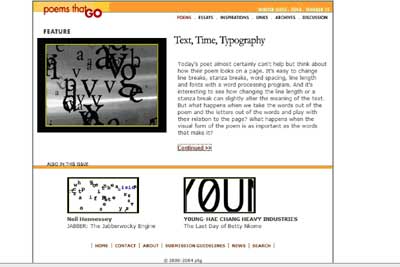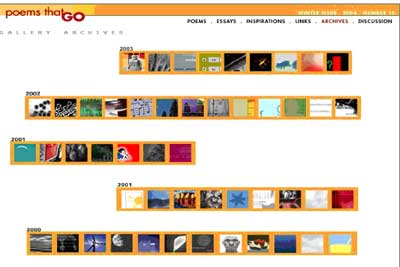Related Categories: Online Journals (Experimental Paradigms)
Summary:
Poems that Go is an online literary journal that showcases kinetic, digital poems. The journal is motivated by the question “What makes a poem a poem?” particularly when that poem is configured in digital form. The site features an extensive collection of Flash-based poems that display poetry to be multimodal and excitingly experimental.
“Poems that Go explores the intersections between motion, sound, image, text, and code. The work we feature explores how language is shaped in new media spaces, how interactivity can change the meaning of a sign, how an image can conflict with a sound, and how code exerts machine-order on a text” (“About”).
Currently, the site has stalled at the Winter 2004 issue, and there is no indication that editors Megan Sapnar and Ingrid Ankerson plan to continue publication. But with its vast archive of genre-specific poetry, Poems that Go remains an important addition to any discussion of online reading practices and their literary products.

Description:
Editors Megan Sapnar and Ingrid Ankerson started Poems that Go in 2000 to create an online space dedicated to “seek[ing] an inclusive understanding of literature, one that goes beyond written text-based works, to include visual, aural and media literacy” (“About”). Although the latest issue is from Winter 2004, a fact that testifies to the stalled status of the quarterly journal, Poems that Go remains an valuable archive of short digital poetry and an important part of the history and evolution of electronic literature.
Later issues of the journal are focused on special topics and introduced with an editorial essay that places the new media works within a tradition of experimental literature. For example, the latest issue (Winter 2004), is titled “text, time, typography” and showcases three works of digital poetry as the latest innovations in concrete poetry. Other past topics include “Literary Games,” “Sound & Web Poetry,” “Reactive Media,” and “Time-Based Media.”
Beyond individual issues, the site situates itself in a constellation of related discourses and online spaces with its “Essays,” “Links,” “Inspirations,” and “Discussion” pages. The “Essays” page includes a hyperlinked list of essays on or about digital poetry and poetics; the “Links” and “Inspirations” pages contain hyperlinked lists of new media projects and journals dedicated to them; the “Discussion” page is an online discussion board (whose latest entry is dated 2002). Like its editors, who are themselves active participants in the electronic literature community, Poems that Go is as a node in a larger, networked community of artists, editors, and readers interested in and dedicated to new media poetics. As the editors explain, there is a certain shared stimulus that prompts both Poems that Go and the community of which it is part, and which it also fosters:
“We’d like to think of this space on the Web as a creative field for this generation’s artists and writers to probe the medium’s potential and integrate these art forms to challenge the definition of poetry. One which challenges you, the new viewers, readers, writers and artists, to discover extraordinary ways to make sense of language, art, and narrative in a way that is both critical and entertaining.”
Research Context:
Poems that Go came onto the scene at a time when journals dedicated to electronic literature (such as Beehive, Riding the Meridian, Born, and The Iowa Review Web) proliferated online. It participated in the introduction of electronic literature to an online reading public and to the development of its reading practices. Amongst this crowd, however, Poems that Go had a distinct focus and the genre of work that it showcased: short, Flash-based pieces in which text and image, sound and movement are in inextricably interwoven. Poems that Go is thus relevant to the Transliteracies Project both as an archive and also as an archival object of study: both for the works it contains in its archives and also as itself an archived part of the evolution of online reading practices.
Technical Analysis:
Poems that Go requires Flash to access the website and works, although individual works may require additional plug-ins as well. The journal has been archived by year rather than issue, enabling the reader to explore the entire contents of the site. Small screenshots serve as clickable icons for accessing individual works:

Evaluation of Opportunities/Limitations for the Transliteracies Topic:
As intimated above, I think Poems that Go has value to the study of how reading practices change due to digital technology for a few obvious reasons. First, as an accessible archive of animated poetry, it is a valuable space for exploring experimentations in new media literature. Second, as an important part of the electronic literature circuit for five years, Poems that Go serves as a valuable testament to how online reading practices have shifted from accessing literature in concentrated locations like literary journals to something more diffuse and distributed, both in terms of the genre and location of these works. As part of this history, Poems that Go provides a means for tracing the evolution of reading and writing practices in new media.
Resources for Further Study:
